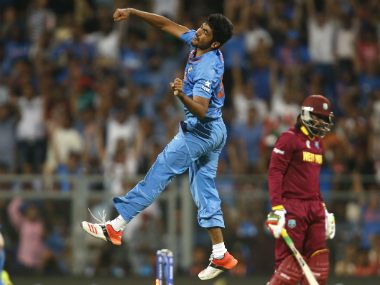If six months ago you had told Jasprit Bumrah that he would have been on top on the list for most T20I wickets in 2016, he probably would have smiled quietly and scoffed mentally. Back then, he hadn’t even played for India. To tell the truth, when I saw his name in the T20I squad that would face Australia, I scoffed mentally. But anyone who saw his debut knew that he could be what the Indian team was looking for: someone with the balls to bowl the death overs. I’m talking of course, about good yorkers. If Game Of Thrones character Daenerys Targaeryen is known as the breaker of chains, one could call Bumrah a breaker of stereotypes. My years at the NCA camps taught me that many a coach believes a perfect bowling action gives one the most chances of success. Yet here is a young man succeeding with an action that is uncoached and inimitable. Here is an Indian bowler who is making waves internationally, without spinning the ball. And here is a fast bowler who does not believe in the need to sledge and abuse the batters. The prone stumps say it all. “Abuse is not on”, Bumrah said in an interview with Hindustan Times last month. “Aggression should be inside.” It is refreshing to see a quick bowler, who can threaten both a batter’s toes and helmet with pace and bravura, without feeling the need to use his tongue as well. Role models like him, along with the entire Black Caps team, will play a great part in teaching youngsters that aggression does not necessarily translate to sledging. [caption id=“attachment_2847284” align=“alignleft” width=“380”]  File photo of Jasprit Bumrah. Reuters[/caption] But Bumrah is a youngster himself. At just 22, he found himself leading the Indian bowling attack in the World T20 earlier this year on home soil, partnering a bowler 15 years his senior. His heterodox action has become MS Dhoni’s secret ingredient in the recipe for T20 success. While his bowling arm finishes between his legs like a traditional inswinger, that is all that is traditional about it. With both his bowling and non-bowling arms remaining fully extended throughout delivery stride, like a pair of cart-wheeling stumps, he generates a high arm speed. The flexion of his wrist at the point of delivery allows his to get good seam position and revolutions on the ball, which accounts for the two-way seam movement he gets off the pitch. It is this movement, along with the angles he creates, that has made him so successful. Bowling is all about angles. With good use of the crease, the same ball can be delivered in six different ways in an over. New Zealand’s Tim Southee is a master at this. But while other bowlers need to make a deliberate effort to create uncomfortable angles, Bumrah has been gifted one naturally. Coupled with a good yorker and deceptive slower ball, the angles have made him difficult to play in T20s, where the format demands that the batter must attack sooner rather than later. This has helped the Punjabi, who plays for Gujarat, to impress his captain on debut, where he took three for 23 in a winning effort. Dhoni went on to hail Bumrah as “the find of the tour”. His international debut and the success that he has enjoyed has been one of the feel-good stories that the IPL parades when under criticism. Drafted to join the Mumbai Indians by John Wright days before the start of the 2013 season, Bumrah suddenly found himself in a team whose bowling spearhead knew a thing or two about freak actions. Lasith Malinga’s influence on Bumrah’s career and his affection for the yorker is well-known. Less widely known is how another Mumbai Indians camper, Shane Bond, helped him overcome a serious knee injury in 2014. “Bond joined the team last year (2015) when I was coming out of an injury. So that helped me quite a lot since he has had his fair share of injuries. He knows how to come back from it”, said Bumrah. Of the 24 T20I wickets Bumrah has taken this year, more than 40 percent of them have been bowled. His inswing and proficiency at the yorker have allowed him to play the oldest and simplest game within cricket: you miss, I hit. And he has shown the ability to execute these skills even when under enormous pressure. Take the WT20 game against Bangladesh this year that India almost lost. While MS Dhoni took the plaudits for the win, Bumrah was entrusted with the penultimate over, which most cricketers will tell you is all-important. Bumrah, who had dropped a catch and fielded badly in the game, soaked up the pressure like blotting paper, and conceded just six runs. Much like his hero Zaheer khan, Bumrah moved from tennis-ball cricket to seriously pursuing his leather dream quite late, at the age of 14. His decision gave his mother Daljeet — raising two children on her own after Bumrah’s father had passed away when he was seven — some pause. A principal at the school where her son also studied, Daljeet Bumrah had always told her pupils to follow their dreams. So despite her apprehensions, she backed her son. And he has repaid her faith. One dream remains, to play Test cricket. Ricky Ponting has already called for his inclusion in the Test squad. But the opinion that matters the most is Bumrah’s itself. “I know where I stand because I have done well in Ranji Trophy. I have played four-day matches for India ‘A’ in Australia so I have the belief since I have done well over there”, said the young man. When people of few words speak, others listen. Jasprit Bumrah is such a young man, and his country is lucky to have him, flailing arms, quiet smile, cartwheeling stumps and all.
Jasprit Bumrah is a fast bowler who does not believe in the need to sledge and abuse the batters. The prone stumps say it all.
Advertisement
End of Article


)

)
)
)
)
)
)
)
)



